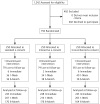An Electronic Tool to Support Patient-Centered Broad Consent: A Multi-Arm Randomized Clinical Trial in Family Medicine
- PMID: 33431386
- PMCID: PMC7800739
- DOI: 10.1370/afm.2610
An Electronic Tool to Support Patient-Centered Broad Consent: A Multi-Arm Randomized Clinical Trial in Family Medicine
Abstract
Purpose: Patients are frequently asked to share their personal health information. The objective of this study was to compare the effects on patient experiences of 3 electronic consent (e-consent) versions asking patients to share their health records for research.
Methods: A multi-arm randomized controlled trial was conducted from November 2017 through November 2018. Adult patients (n = 734) were recruited from 4 family medicine clinics in Florida. Using a tablet computer, participants were randomized to (1) a standard e-consent (standard), (2) an e-consent containing standard information plus hyperlinks to additional interactive details (interactive), or (3) an e-consent containing standard information, interactive hyperlinks, and factual messages about data protections and researcher training (trust-enhanced). Satisfaction (1 to 5), subjective understanding (0 to 100), and other outcomes were measured immediately, at 1 week, and at 6 months.
Results: A majority of participants (94%) consented to future uses of their health record information for research. No differences in study outcomes between versions were observed at immediate or 1-week follow-up. At 6-month follow-up, compared with the standard e-consent, participants who used the interactive e-consent reported greater satisfaction (B = 0.43; SE = 0.09; P <.001) and subjective understanding (B = 18.04; SE = 2.58; P <.001). At 6-month follow-up, compared with the interactive e-consent, participants who used the trust-enhanced e-consent reported greater satisfaction (B = 0.9; SE = 1.0; P <.001) and subjective understanding (B = 32.2; SE = 2.6, P <.001).
Conclusions: Patients who used e-consents with interactive research details and trust-enhancing messages reported higher satisfaction and understanding at 6-month follow-up. Research institutions should consider developing and further validating e-consents that interactively deliver information beyond that required by federal regulations, including facts that may enhance patient trust in research.
Keywords: consumer health informatics; electronic health records; health communication; informed consent; trust.
© 2021 Annals of Family Medicine, Inc.
Figures






Similar articles
-
Does an interactive trust-enhanced electronic consent improve patient experiences when asked to share their health records for research? A randomized trial.J Am Med Inform Assoc. 2019 Jul 1;26(7):620-629. doi: 10.1093/jamia/ocz015. J Am Med Inform Assoc. 2019. PMID: 30938751 Free PMC article. Clinical Trial.
-
Telemedicine Provides Noninferior Research Informed Consent for Remote Study Enrollment: A Randomized Controlled Trial.Acad Emerg Med. 2016 Jul;23(7):759-65. doi: 10.1111/acem.12966. Epub 2016 Jun 18. Acad Emerg Med. 2016. PMID: 26990899 Free PMC article. Clinical Trial.
-
Electronic Consent at US Cancer Centers: A Survey of Practices, Challenges, and Opportunities.JCO Clin Cancer Inform. 2023 Jan;7:e2200122. doi: 10.1200/CCI.22.00122. JCO Clin Cancer Inform. 2023. PMID: 36595735 Free PMC article.
-
Implementation of Electronic Informed Consent in Biomedical Research and Stakeholders' Perspectives: Systematic Review.J Med Internet Res. 2020 Oct 8;22(10):e19129. doi: 10.2196/19129. J Med Internet Res. 2020. PMID: 33030440 Free PMC article.
-
Electronic consent in clinical care: an international scoping review.BMJ Health Care Inform. 2023 Jul;30(1):e100726. doi: 10.1136/bmjhci-2022-100726. BMJ Health Care Inform. 2023. PMID: 37423643 Free PMC article.
Cited by
-
Personalized and longitudinal electronic informed consent in clinical trials: How to move the needle?Digit Health. 2024 Jan 23;10:20552076231222361. doi: 10.1177/20552076231222361. eCollection 2024 Jan-Dec. Digit Health. 2024. PMID: 38269372 Free PMC article.
-
The use of large language models to enhance cancer clinical trial educational materials.JNCI Cancer Spectr. 2025 Mar 3;9(2):pkaf021. doi: 10.1093/jncics/pkaf021. JNCI Cancer Spectr. 2025. PMID: 39921887 Free PMC article.
-
Patient Perspectives and Preferences for Consent in the Digital Health Context: State-of-the-art Literature Review.J Med Internet Res. 2023 Feb 10;25:e42507. doi: 10.2196/42507. J Med Internet Res. 2023. PMID: 36763409 Free PMC article. Review.
-
An Integrated, Scalable, Electronic Video Consent Process to Power Precision Health Research: Large, Population-Based, Cohort Implementation and Scalability Study.J Med Internet Res. 2021 Dec 8;23(12):e31121. doi: 10.2196/31121. J Med Internet Res. 2021. PMID: 34889741 Free PMC article.
-
Knowledge and Attitudes of Research Participants in China Toward Electronic Informed Consent in Clinical Trials: A Cross Sectional Study.J Empir Res Hum Res Ethics. 2022 Jul;17(3):362-372. doi: 10.1177/15562646221075884. Epub 2022 Jan 28. J Empir Res Hum Res Ethics. 2022. PMID: 35088620 Free PMC article.
References
-
- Ohno-Machado L, Alipanah N, Day M, et al. . Clinical Data Research Networks, Patient Registries and Patient Powered Research Networks, Taxonomy and Comprehensive Inventories. Patient Centered Outcomes Research Institute (PCORI); 2013.
-
- Califf RM, Robb MA, Bindman AB, et al. . Transforming evidence generation to support health and health care decisions. N Engl J Med. 2016; 375(24): 2395-2400. - PubMed
-
- Bayley KB, Belnap T, Savitz L, Masica AL, Shah N, Fleming NS.. Challenges in using electronic health record data for CER: experience of 4 learning organizations and solutions applied. Med Care. 2013; 51(8)(Suppl 3): S80-S86. - PubMed
-
- Federal Policy for the Protection of Human Subjects. In: (OHRP) OfHRP, ed. Vol 45 CFR 46.101. Vol 82, No. 12 ed2018.
Publication types
MeSH terms
Grants and funding
LinkOut - more resources
Full Text Sources
Other Literature Sources
